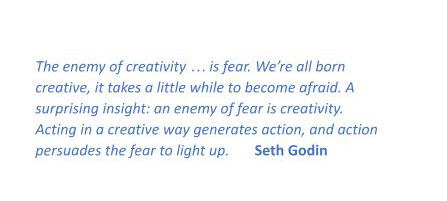Creativity.
Have you ever thought about how creativity could be considered a bad word?
It may seem strange that at a place like TSA we should ponder how “creativity” could be considered a bad word. After all, TSA seems to be a consistent and constant vehicle for creative exploration and expression. Students, teachers, staff and administration are often challenged to engage and activate their creative abilities.
So, how might creativity be considered a bad word?
To dig into that concept we might need to think about conversations that take place. Maybe it is a conversation that we have had. Or it might be a conversation we have heard. The type of conversation I’m talking about often includes something like this …
“You are so creative. I could never do anything like that!”
“I do a little bit of _____________ (painting, singing, acting, etc.) but I’m no ____________ (artist, musician, actor, etc.).”
“Oh, that? Yeah, I painted that. But, you know, I don’t have any training and its really not very good.”
“I like writing and composing – but I’d never show anyone my work.”
“I don’t have a creative bone in my body. I just know how to __________ (organize; make plans; weld; cook; fix things; do plumbing; start a business).
Sometimes things like this are said by people that are already engaged in creative endeavors. Other times they could be said by people who do not think that they are – in any way – creative or that anything they do could be considered creative. Either way, there seems to be a common undercurrent in these statements and this type of thinking: fear.

We don’t need to let fear dictate our willingness to engage our own creativity. We don’t need to hold onto perceptions that, somehow, that creativity is for those people.
CREATIVITY doesn’t need to be a bad word!
There is good news. We can take action. We can learn to recognize aspects of creativity that we already employ and use that recognition to encourage our exploration of creativity in other avenues. We can intentionally make a departure from society’s norms – or even our own biases – that would view “artists” as the only creatives. We can find and use bigger definitions for creativity.
In business (and many other fields) creativity is often called innovation. Adaptation is creativity employed in building upon pre-existing work or concepts. Invention is deeply creative. There are many other expressions of creativity that may not “fit” the limitations of the creativity=artistry perception.
Organization – people who are good at organizing create a system to organize items, a group, information or an event.
Creative thinking – many people are creative thinkers in their specific field. Often using their experience (and their talent) they are able to bring together thoughts that don’t easily occur to others.
Problem-solving – much like creative thinkers, problem-solvers are able to see solutions that may escape others. What is more, great problem-solvers can amaze others by solving more than one problem with just one solution … OR solving two problems by matching two problems together. [#1) I don’t know how I am going to get across town. #2) We need this van to get to the dealership – but we don’t have anyone to drive it.]
Plumbing – Plumbers may not see themselves as creative – but they often have to go through extensive analysis and investigation of a problem (involving a lot of creative thinking) then initiate an elaborate series of solutions that correspond with the specific circumstances of the building. And then, if you were to take away the building and leave “just” the copper structure – it might look very much like a large copper sculpture!
Cooking, Construction – … something doesn’t exist and then it does. A finished product (dinner, chair, house) is created from a stack of “ingredients”.
Why? Why do people (artists included) distance themselves from new creative challenges? How does fear manifest itself in our thinking about creativity? Does it, perhaps, feel safer to not engage the possibility – to not take the risk? Take a glass-blowing class. Try getting a sketchbook and some pencils. Find some YouTube videos on a creative activity that interests you. Ask people that do what you are interested in about their story. How did they get started? Just like the illustration for cooking and construction needing ingredients/materials, sometimes the available “ingredients” for a creative pursuit are time, need, opportunity, or ideas.
If you know someone who you think is aching to experience new creativity – encourage them.
If that is you, give yourself room to discover – discover your interests, discover some new thinking, some new perspectives. While you’re forging ahead in all of this discovery, do all you can to be engaged at an elemental (child-like) level of creativity. Be patient with yourself as you (little by little) develop new skills. Give yourself freedom to explore, to try. Make an effort to do something creative without the pressure to be an “expert” or to have a specific (high-quality) “outcome”.
Creativity… Have fun. Enjoy.
Devin Bader, Assistant Artistic Director
(Seth Godin quote: https://www.azquotes.com/quote/880455 – Oct. 22, 2021)

